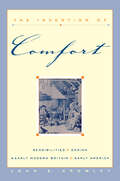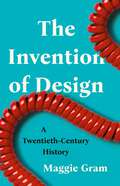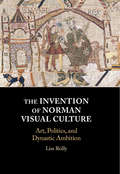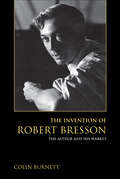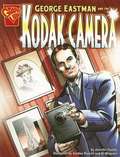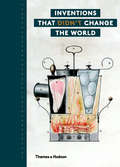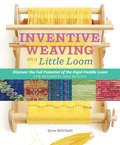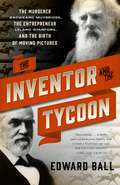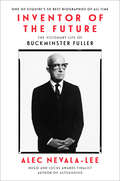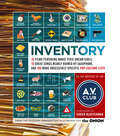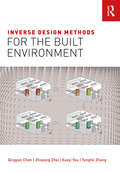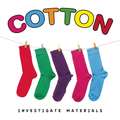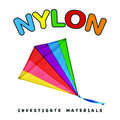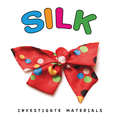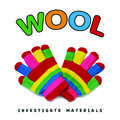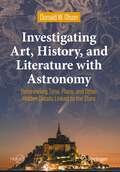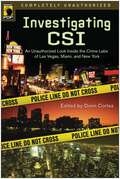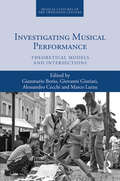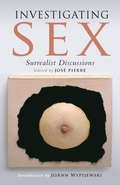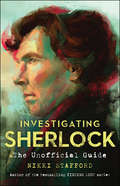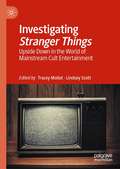- Table View
- List View
The Invention of Comfort: Sensibilities and Design in Early Modern Britain and Early America
by John E. CrowleyA history and analysis of the development of domestic design in early modern Britain and America.How did our modern ideas of physical well-being originate? As John Crowley demonstrates in The Invention of Comfort, changes in sensible technology owed a great deal to fashion-conscious elites discovering discomfort in surroundings they earlier had felt to be satisfactory.Written in an engaging style that will appeal to historians and material culture specialists as well as to general readers, this pathbreaking work brings together such disparate topics of analysis as climate, fire, food, clothing, the senses, and anxiety—especially about the night.“Riveting. . . . A solid contribution to the literature on the cultural impact of gentility, refinement, and the “baubles of Britain” in England and its colonial possessions.” —Journal of American History“Crowley provides a masterly search and survey that no historian of material culture should miss, and every curious reader should consider.” —Eugen Weber, Phi Beta Kappa Key Reporter“A comprehensive and tight study . . . a valuable contribution to the field, [and] one that is enjoyable to read.” —Emma Hart, English Historical Review“The sheer range of evidence, the interweaving of themes, and the overall strength of the argument mean [this] is an ideal book for specialists and students alike.” —Helen Clifford, Journal of Design History“The Invention of Comfort is an important and thought-provoking book that challenges our understanding of why people live that way they do.” —Marie Morgan, New England Quarterly
The Invention of Design: A Twentieth-Century History
by Maggie GramFrom a brilliant cultural historian, &“a secret history of the twentieth century&” (Louis Menand) told through the story of design and its utopian promises Design has penetrated every dimension of contemporary society, from classrooms to statehouses to corporate boardrooms. It&’s seen as a kind of mega-power, one that can solve all our problems and elevate our experiences to make a more beautiful, more functional world. But there&’s a backstory here. In The Invention of Design, designer and historian Maggie Gram investigates how, over the twentieth century, our economic hopes, fears, and fantasies shaped the idea of &“design&”—then repeatedly redefined it. Nearly a century ago, resistance to New Deal–era government intervention helped transform design from an idea about aesthetics into one about function. And at century&’s end, the dot-com crash brought us &“design thinking&”: the idea that design methodology can solve any problem, small or large. To this day, design captures imaginations as a tool for fixing market society&’s broken parts from within, supposedly enabling us to thrive within capitalism&’s sometimes violent constraints. A captivating critical history, The Invention of Design shows how design became the hero of many of our most hopeful stories—dreams, fantasies, utopias—about how we might better live in a modern world.
The Invention of Norman Visual Culture: Art, Politics, and Dynastic Ambition
by Lisa ReillyIn this book, Lisa Reilly establishes a new interpretive paradigm for the eleventh and twelfth-century art and architecture of the Norman world in France, England, and Sicily. Traditionally, scholars have considered iconic works like the Cappella Palatina and the Bayeux Embroidery in a geographically piecemeal fashion that prevents us from seeing their full significance. Here, Reilly examines these works individually and within the larger context of a connected Norman world. Just as Rollo founded the Normandy 'of different nationalities', the Normans created a visual culture that relied on an assemblage of forms. To the modern eye, these works are perceived as culturally diverse. As Reilly demonstrates, the multiple sources for Norman visual culture served to expand their meaning. Norman artworks represented the cultural mix of each locale, and the triumph of Norman rule, not just as a military victory but as a legitimate succession, and often as the return of true Christian rule.
The Invention of Public Space: Designing for Inclusion in Lindsay's New York
by Mariana MogilevichThe interplay of psychology, design, and politics in experiments with urban open space As suburbanization, racial conflict, and the consequences of urban renewal threatened New York City with &“urban crisis,&” the administration of Mayor John V. Lindsay (1966–1973) experimented with a broad array of projects in open spaces to affirm the value of city life. Mariana Mogilevich provides a fascinating history of a watershed moment when designers, government administrators, and residents sought to remake the city in the image of a diverse, free, and democratic society.New pedestrian malls, residential plazas, playgrounds in vacant lots, and parks on postindustrial waterfronts promised everyday spaces for play, social interaction, and participation in the life of the city. Whereas designers had long created urban spaces for a broad amorphous public, Mogilevich demonstrates how political pressures and the influence of the psychological sciences led them to a new conception of public space that included diverse publics and encouraged individual flourishing. Drawing on extensive archival research, site work, interviews, and the analysis of film and photographs, The Invention of Public Space considers familiar figures, such as William H. Whyte and Jane Jacobs, in a new light and foregrounds the important work of landscape architects Paul Friedberg and Lawrence Halprin and the architects of New York City&’s Urban Design Group.The Invention of Public Space brings together psychology, politics, and design to uncover a critical moment of transformation in our understanding of city life and reveals the emergence of a concept of public space that remains today a powerful, if unrealized, aspiration.
The Invention of Robert Bresson: The Auteur and His Market
by Colin BurnettChallenging the prevailing notion among cinephiles that the auteur is an isolated genius interested primarily in individualism, Colin Burnett positions Robert Bresson as one whose life's work confronts the cultural forces that helped shape it. Regarded as one of film history's most elusive figures, Bresson (1901–1999) carried himself as an auteur long before cultural magazines, like the famed Cahiers du cinéma, advanced the term to describe such directors as Jacques Tati, Alfred Hitchcock, and Jean-Luc Godard. In this groundbreaking study, Burnett combines biography with cultural history to uncover the roots of the auteur in the alternative cultural marketplace of midcentury France.
An Invention without a Future
by James NaremoreIn 1895, Louis Lumière supposedly said that cinema is "an invention without a future." James Naremore uses this legendary remark as a starting point for a meditation on the so-called death of cinema in the digital age, and as a way of introducing a wide-ranging series of his essays on movies past and present. These essays include discussions of authorship, adaptation, and acting; commentaries on Howard Hawks, Alfred Hitchcock, Orson Welles, Vincente Minnelli, John Huston, and Stanley Kubrick; and reviews of more recent work by non-Hollywood directors Pedro Costa, Abbas Kiarostami, Raúl Ruiz, and Apichatpong Weerasethakul. Important themes recur: the relations between modernity, modernism, and postmodernism; the changing mediascape and death of older technologies; and the need for robust critical writing in an era when print journalism is waning and the humanities are devalued. The book concludes with essays on four major American film critics: James Agee, Manny Farber, Andrew Sarris, and Jonathan Rosenbaum.
Inventions and Discovery: George Eastman and the Kodak Camera
by Jennifer Fandel Gordon Purcell Al Milgrom Mandy RobbinsIn graphic novel format, tells the story of how George Eastman developed the Kodak camera, and how this company changed the way people captured the moments of their lives.
Inventions That Didn't Change the World
by Julie HallsA captivating, humorous, and downright perplexing selection of nineteenth-century inventions as revealed through remarkable-and hitherto unseen-illustrations from the British National Archive Inventions that Didn't Change the World is a fascinating visual tour through some of the most bizarre inventions registered with the British authorities in the nineteenth century. In an era when Britain was the workshop of the world, design protection (nowadays patenting) was all the rage, and the apparently lenient approval process meant that all manner of bizarre curiosities were painstakingly recorded, in beautiful color illustrations and well-penned explanatory text, alongside the genuinely great inventions of the period. Irreverent commentary contextualizes each submission as well as taking a humorous view on how each has stood the test of time. This book introduces such gems as a ventilating top hat; an artificial leech; a design for an aerial machine adapted for the arctic regions; an anti-explosive alarm whistle; a tennis racket with ball-picker; and a currant-cleaning machine. Here is everything the end user could possibly require for a problem he never knew he had. Organized by area of application--industry, clothing, transportation, medical, health and safety, the home, and leisure--Inventions that Didn't Change the World reveals the concerns of a bygone era giddy with the possibilities of a newly industrialized world.
Inventive Weaving on a Little Loom: Discover the Full Potential of the Rigid-Heddle Loom, for Beginners and Beyond
by Syne MitchellRigid-heddle weaving is simple to learn, is easy to master, and offers a lifetime of possibilities to discover! Inventive Weaving on a Little Loom covers everything rigid-heddle weavers need to know about the craft, from the basics — how to select a loom, set it up, and get started — to a wide variety of fun techniques that yield beautiful results. Begin by exploring a variety of weave structures, including finger-manipulated laces, tapestry, and color play with stripes, plaids, and multicolor yarns. Then move on to more complex designs and irresistible projects, from pillows and curtains to bags, shawls, and even jewelry. Explore warp-face patterning, weft-pile weaving, weaving with fine threads, woven shibori, shadow weave, and the textural effects you can create with different yarns and with wire and conductive thread. Everything you need to know is here, with fully illustrated step-by-step instructions to ensure success.
The Inventor and the Tycoon: A Gilded Age Murder and the Birth of Moving Pictures
by Edward BallFrom the National Book Award-winning author of Slaves in the Family, a riveting true life/true crime narrative of the partnership between the murderer who invented the movies and the robber baron who built the railroads. One hundred and thirty years ago Eadweard Muybridge invented stop-motion photography, anticipating and making possible motion pictures. He was the first to capture time and play it back for an audience, giving birth to visual media and screen entertainments of all kinds. Yet the artist and inventor Muybridge was also a murderer who killed coolly and meticulously, and his trial is one of the early instances of a media sensation. His patron was railroad tycoon (and former California governor) Leland Stanford, whose particular obsession was whether four hooves of a running horse ever left the ground at once. Stanford hired Muybridge and his camera to answer that question. And between them, the murderer and the railroad mogul launched the age of visual media. Set in California during its frontier decades, The Tycoon and the Inventor interweaves Muybridge's quest to unlock the secrets of motion through photography, an obsessive murder plot, and the peculiar partnership of an eccentric inventor and a driven entrepreneur. A tale from the great American West, this popular history unspools a story of passion, wealth, and sinister ingenuity.
Inventor Confidential: The Honest Guide to Profitable Inventing
by Warren TuttleThe President of the United Inventors Association shows inventors, innovators, and makers a savvier, safer path towards monetizing your better mouse trap and how to avoid the get-rich-quick scammers.The road to licensing a profitable, innovative product or technology is riddled with curves, holes, and rocky cliffs. Every year, hundreds of thousands of eager inventors around the globe spend millions of dollars seeking assistance from inventor service companies and individuals claiming to be experts in the innovation and licensing fields, though their actual success rates are poor in relation to the dollar amounts they charge.The reality is, according to Inventors&’ Digest™, while 78% of new inventors believe they will make over a million dollars with their inventions, less than 1% actually do. Marketers prey on this scenario for their own financial gain.Inventor Confidential tips the odds back in the investor&’s favor, helping them: Gain a much broader picture of the many current challenges that inventors face these days.Understand the red flags to watch out for when individuals or companies charge up front for their coaching or help-to-market services.See how inventors can improve their odds of licensing success by following a thorough product development protocol, creating working prototypes, and filing U.S. patents.Get the insider perspective on how companies determine the quality of a product submission and if they want to work with the inventor.Learn the 30 steps to market if you want to go it alone.For anyone who has a great idea or invention and wants to monetize it but are not sure who to trust, Inventor Confidential will show them where to best spend their hard-earned money to maximize their odds for success.
Inventor of the Future: The Visionary Life of Buckminster Fuller
by Alec Nevala-LeeOne of Esquire's 50 Best Biographies of All Time * One of The Economist's Best Books of 2022 * A New York Times Book Review Editors' Choice * Nominated for The Next Big Idea Club * The Week Magazine Book of the WeekFrom Alec Nevala-Lee, the author of the Hugo and Locus Award finalist Astounding, comes a revelatory biography of the visionary designer who defined the rules of startup culture and shaped America’s idea of the future. During his lifetime, Buckminster Fuller was hailed as one of the greatest geniuses of the twentieth century. As the architectural designer and futurist best known for the geodesic dome, he enthralled a vast popular audience, inspired devotion from both the counterculture and the establishment, and was praised as a modern Leonardo da Vinci. To his admirers, he exemplified what one man could accomplish by approaching urgent design problems using a radically unconventional set of strategies, which he based on a mystical conception of the universe’s geometry. His views on sustainability, as embodied in the image of Spaceship Earth, convinced him that it was possible to provide for all humanity through the efficient use of planetary resources. From Epcot Center to the molecule named in his honor as the buckyball, Fuller’s legacy endures to this day, and his belief in the transformative potential of technology profoundly influenced the founders of Silicon Valley.Inventor of the Future is the first authoritative biography to cover all aspects of Fuller’s career. Drawing on meticulous research, dozens of interviews, and thousands of unpublished documents, Nevala-Lee has produced a riveting portrait that transcends the myth of Fuller as an otherworldly generalist. It reconstructs the true origins of his most famous inventions, including the Dymaxion Car, the Wichita House, and the dome itself; his fraught relationships with his students and collaborators; his interactions with Frank Lloyd Wright, Isamu Noguchi, Clare Boothe Luce, John Cage, Steve Jobs, and many others; and his tumultuous private life, in which his determination to succeed on his own terms came at an immense personal cost. In an era of accelerating change, Fuller’s example remains enormously relevant, and his lessons for designers, activists, and innovators are as powerful and essential as ever.
Inventory
by Chuck Klosterman A. V. ClubEach week, the writers of The A.V. Club issue a slightly slanted pop-culture list filled with challenging opinions (Is David Bowie's "Young Americans" nearly ruined by saxophone?) and fascinating facts. Exploring 24 great films too painful to watch twice, 14 tragic movie-masturbation scenes, 18 songs about crappy cities, and much more, Inventory combines a massive helping of new lists created especially for the book with a few favorites first seen at avclub.com and in the pages of The A.V. Club's sister publication, The Onion. But wait! There's more: John Hodgman offers a set of minutely detailed (and probably fictional) character actors. Patton Oswalt waxes ecstatic about the "quiet film revolutions" that changed cinema in small but exciting ways. Amy Sedaris lists 50 things that make her laugh. "Weird Al" Yankovic examines the noises of Mad magazine's Don Martin. Plus lists from Paul Thomas Anderson, Robert Ben Garant, Tom Lennon, Andrew W.K., Tim and Eric, Daniel Handler, and Zach Galifianakis -- and an epic foreword from essayist Chuck Klosterman.
Inverse Design Methods for the Built Environment
by Qingyan Chen Zhiqiang Zhai Xueyi You Tengfei ZhangThe inverse design approach is new to the built environment research and design community, though it has been used in other industries including automobile and airplane design. This book, from some of the pioneers of inverse design applications in the built environment, introduces the basic principles of inverse design and the specific techniques that can be applied to built environment systems. The authors' inverse design concept uses the desired enclosed environment as the design objective and inversely determines the systems required to achieve the objective. The book discusses a number of backward and forward methods for inverse design. Backward methods, such as the quasi-reversibility method, the pseudo-reversibility method, and the regularized inverse matrix method, can be used to identify contaminant sources in an enclosed environment. However, these methods cannot be used to inversely design a desired indoor environment. Forward methods, such as the computational-fluid-dynamics (CFD)-based genetic algorithm (GA) method, the CFD-based adjoint method, the CFD-based artificial neural network (ANN) method, and the CFD-based proper orthogonal decomposition (POD) method, show the promise in the inverse design of airflow and heat transfer in an enclosed environment. The book describes the fundamentals of the methods for beginners, provides exciting design examples for the reader to duplicate, discusses the pros and cons of each design method and points out the knowledge gaps for further development.
Investigate Materials: COTTON
by Nomad PressModern, bright photography and age-appropriate text engage young learners in an exploration of everyday materials in this new series. Using simple, colorful, familiar objects to demonstrate the characteristics of such textiles as silk, cotton, wool, and nylon, each installment encourages readers to ask and answer questions and to plan and conduct simple investigations. Based on National Science Education Standards, this series is an ideal supplement for preschool and kindergarten teachers and offers parents a unique opportunity to prepare youngsters for formal education. With such questions as How is cotton made? and What does cotton look and feel like?, this volume takes a closer look at this everyday material and how it relates to its textile counterparts.
Investigate Materials: NYLON
by Nomad PressModern, bright photography and age-appropriate text engage young learners in an exploration of everyday materials in this new series. Using simple, colorful, familiar objects to demonstrate the characteristics of such textiles as silk, cotton, wool, and nylon, each installment encourages readers to ask and answer questions and to plan and conduct simple investigations. Based on National Science Education Standards, this series is an ideal supplement for preschool and kindergarten teachers and offers parents a unique opportunity to prepare youngsters for formal education. Words to know, interesting facts, and fun photography help early learners explore the properties of nylon. Asking such questions as What is nylon and where do we get it? and Why is nylon slippery?, this book uses scientific inquiry to determine the characteristics that make it different from other textiles.
Investigate Materials: SILK
by Nomad PressModern, bright photography and age-appropriate text engage young learners in an exploration of everyday materials in this new series. Using simple, colorful, familiar objects to demonstrate the characteristics of such textiles as silk, cotton, wool, and nylon, each installment encourages readers to ask and answer questions and to plan and conduct simple investigations. Based on National Science Education Standards, this series is an ideal supplement for preschool and kindergarten teachers and offers parents a unique opportunity to prepare youngsters for formal education. Using a question-and-answer approach and a variety of interactive prompts--such as words to know and important facts--students will learn the various properties that make silk a unique member of the textile family.
Investigate Materials: WOOL
by Nomad PressModern, bright photography and age-appropriate text engage young learners in an exploration of everyday materials in this new series. Using simple, colorful, familiar objects to demonstrate the characteristics of such textiles as silk, cotton, wool, and nylon, each installment encourages readers to ask and answer questions and to plan and conduct simple investigations. Based on National Science Education Standards, this series is an ideal supplement for preschool and kindergarten teachers and offers parents a unique opportunity to prepare youngsters for formal education. Including photographic examples, interesting facts, and important words related to wool, this interactive exploration uses a question-and-answer approach that allows youngsters to make discoveries about this rough fabric and its similarities and differences with other materials.
Investigating Art, History, and Literature with Astronomy: Determining Time, Place, and Other Hidden Details Linked to the Stars (Springer Praxis Books)
by Donald W. OlsonHow can shadows determine the date and time of a painting by Johannes Vermeer? How did the Moon and tides cause the loss of King John’s crown jewels? In his newest book, Professor Olson, author of Celestial Sleuth and Further Adventures of the Celestial Sleuth, explores how astronomical clues can uncover fascinating new details about art, history, and literature. He begins with an accessible introduction to amateur “celestial sleuthing,” showing how to use your astronomical knowledge, software, archives, vintage maps, historical letters and diaries, military records, and other resources to investigate the past. Follow along as Professor Olson then explores twenty real-world cases where astronomy has helped answer unresolved questions or correct longstanding interpretations about an event. Examples involve artists such as Vermeer, Monet, and O’Keeffe; the historical exploits of Alexander the Great, the desert travels of the Death Valley ’49ers, and a meeting between Franklin D. Roosevelt and Winston Churchill in Marrakech; and literary works by Chaucer, Shakespeare, and Longfellow. Packed with dozens of full-color illustrations, this book will enrich your knowledge of the past and equip you with all the tools you’ll need to become a celestial sleuth yourself. “Many people have a passion for art, or world history, or great literature, or even astronomy — but seldom in all these things at once. This remarkable book by Donald Olson of Texas State University will put you in touch with such seemingly unrelated endeavors. It will open your eyes and broaden your mind as little else could.” Roger W. Sinnott, Sky & Telescope
Investigating CSI: Inside the Crime Labs of Las Vegas, Miami and New York
by Donn Cortez with Leah WilsonThis selection of smart, accessible essays covers CSI's cutting-edge science, intriguing mysteries, and engaging personal dynamics. Essays from experts in the field illuminate such processes as DNA testing, ballistics, crime-scene photography, and autopsy procedure. With pieces that focus on the leads' varying appeals, the history of forensics on television, the show's treatment of alternate sexualities, and whether the incredible attention to detail actually gives criminals an advantage, this anthology provides an in-depth investigation that enriches the viewing experience.
Investigating Musical Performance: Theoretical Models and Intersections (Musical Cultures of the Twentieth Century)
by Gianmario Borio Giovanni Giuriati Alessandro Cecchi Marco LutzuInvestigating Musical Performance considers the wide range of perspectives on musical performance made tangible by the cross-disciplinary studies of the last decades and encourages a comparison and revision of theoretical and analytical paradigms. The chapters present different approaches to this multi-layered phenomenon, including the results of significant research projects. The complex nature of musical performance is revealed within each section which either suggests aspects of dialogue and contiguity or discusses divergences between theoretical models and perspectives. Part I elaborates on the history, current trends and crucial aspects of the study of musical performance; Part II is devoted to the development of theoretical models, highlighting sharply distinguished positions; Part III explores the relationship between sign and sound in score-based performances; finally, the focus of Part IV centres on gesture considered within different traditions of musicmaking. Three extra chapters by the editors complement Parts I and III and can be accessed via the online Routledge Music Research Portal. The volume shows actual and possible connections between topics, problems, analytical methods and theories, thereby reflecting the wealth of stimuli offered by research on the musical cultures of our times.
Investigating Quality of Urban Life
by Robert J. Stimson Robert W. MaransThe study of quality of urban life involves both an objective approach to analysis using spatially aggregated secondary data and a subjective approach using unit record survey data whereby people provide subjective evaluations of QOL domains. This book provides a comprehensive overview of theoretical perspectives on QOUL and methodological approaches to research design to investigate QOUL and measure QOL dimensions. It incorporates empirical investigations into QOUL in a range of cities across the world.
Investigating Sex
by Jose Pierre Dawn AdesIn January 1928, the surrealists initiated their remarkable "researches into sexuality" with a series of round-table conversations involving key figures such as André Breton, Yves Tanguy, Louis Aragon, Man Ray, Max Ernst and Antonin Artaud. The transcripts, in all their bizarre and fascinating detail, are presented here. While there is plenty of humor--not all of it intentional--the speakers were trying scrupulously to record every aspect of sexual love, cataloging preferences and positions, quality and quantity. This book is a unique historical record of sexual practice and ethics; a fundamental text for understanding the surrealist movement and, for all its idiosyncrasies, a document that still retains an extraordinary vitality today.From the Hardcover edition.
Investigating Sherlock: The Unofficial Guide
by Nikki StaffordAn &“intelligent and lively&” companion to the hit BBC show starring Benedict Cumberbatch (Publishers Weekly). He&’s been depicted as a serious thinker, a master of deduction, a hopeless addict, and a bare-knuckle fighter. His companion is a bumbler, a sympathetic equal, someone helpless in the face of his friend&’s social inadequacies. Sherlock Holmes and John Watson remain the most-adapted fictional characters of all time. In 2010, when Benedict Cumberbatch and Martin Freeman stepped into the roles, they managed to meld many previous incarnations into two glorious performances. Over Sherlock&’s first three seasons, the Emmy Award–winning series has brought new life to stories over a century old and, with its Holmes and Watson for the twenty-first century, created a worldwide phenomenon. Investigating Sherlock examines each episode through in-depth and fun analysis, exploring the character development and cataloguing every subtle reference to the original stories. With biographies of Cumberbatch and Freeman, as well as Arthur Conan Doyle, Investigating Sherlock is great fun, and the ultimate guide to the great detective. &“One of the best-researched books out there on the BBC Show, with great interviews of the show&’s creators and primary actors.&” —GeekDad
Investigating Stranger Things: Upside Down in the World of Mainstream Cult Entertainment
by Tracey Mollet Lindsey ScottThis edited collection explores the narrative, genre, nostalgia and fandoms of the phenomenally successful Netflix original series, Stranger Things. The book brings together scholars in the fields of media, humanities, communications and cultural studies to consider the various ways in which the Duffer Brothers’ show both challenges and confirms pre-conceived notions of cult media. Through its three sections on texts, contexts and receptions, the collection examines all aspects of the series’ presence in popular culture, engaging in debates surrounding cult horror, teen drama, fan practices, and contemporary anxieties in the era of Trump. Its chapters seek to address relatively neglected areas of scholarship in the realm of cult media, such as set design, fashion, and the immersive Secret Cinema Experience. These discussions also serve to demonstrate how cult texts are facilitated by the new age of television, where notions of medium specificity are fundamentally transformed and streaming platforms open up shows to extensive analysis in the now mainstream world of cult entertainment.
